Palazzo Vecchio Art Story | Location | Opening Hours Tickets | Authorizations
Art Story Five-Hundred | Tower | Vasari Halls | Dante Mask | Ghirlandaio | Bronzino Sarto Daddi | Salviati | Cortile
Five-Hundred Hall Hall and Ceiling | Ceiling Paintings | Pisa War | Siena War | Sculptures
Ceiling Paintings Cosimo I Medici | Florence History | Wars and Battles | Tuscany
Allegories of Tuscany Paintings of the Ceiling of the Hall of Five Hundred of the Palazzo Vecchio in Florence
Giorgio Vasari and Giovanni Stradano, “Allegory of Mugello”, Ceiling of the Hall of Five Hundred of Palazzo Vecchio in Florence
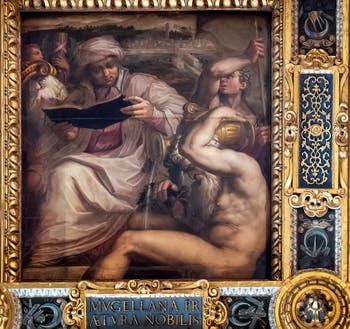
Allegory of Mugello Painting - Oil on Wood - 1563-1565
In this allegory of the Mugello region, one sees sitting a judge with, just above him, a putto holding a scroll of documents, a symbol of the court for Administration and Justice.
In the background, you can see the city of Scarperia.
A young man holds the flag of the country.
At his feet, the old man pouring water represents the Sieve River.
Under the allegory, Vasari painted these words:
“MUGELLANA PRAETURA NOBILIS”.
Giorgio Vasari and Giovanni Stradano, “Allegory of Fiesole”, Ceiling of the Hall of Five Hundred of Palazzo Vecchio in Florence
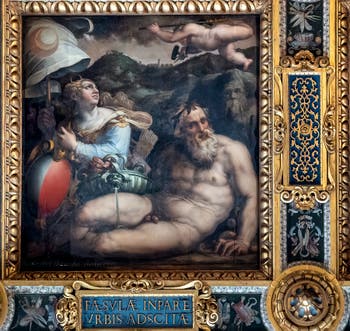
Allegory of Fiesole This allegory shows Fiesole with the Mugnone River at its feet which holds a basin from which water flows.
Diana huntress with her quiver is depicted on the left with a standard on which one sees a Moon on a white background, the ancient symbol of the city of Fiesole.
The coat of arms held by Diane, in white and red colours, represents the city's arms.
Next to it, a stone Atlantean represents this rocky region.
Finally, in the upper part, one can see a flying putto with a bishop's crozier to pay tribute to the bishopric of Fiesole.
This putto also carries in the other hand a hammer, a chisel and a compass.
Under the allegory is written: “FAESULAE IN PARTE URBS ADSCITE”.
Giorgio Vasari and Giovanni Stradano and Giovanni Battista Naldini, “Allegory of Arezzo” Ceiling of the Hall of Five Hundred of Palazzo Vecchio in Florence
Arezzo is the hometown of Vasari.
Allegory of Arezzo He depicted it with the old man who symbolizes the Castro River in the foreground and on the right, which holds a horn of abundance and a large vase from which the river's water flows.
Behind Castro, we see Ceres holding spikes and a scythe symbolizing the abundance of crops in the region.
On the left, the god Mars in armour holds the city standard with a black horse on a white background and in the full race.
Mars also holds the coat of arms of Arezzo with its white cross on a red background.
The flying putto holding a bishop's crozier symbolizes the bishopric of Arezzo, but unlike the putti of other allegories, he also has a sword in the other hand.
This sword refers to the warrior bishop Guido Tarlati of Petramala, who was the last prince of the city and ruled Arezzo both spiritually and temporally.
The allegory reads: “ARRETIU [M] NOBILIS ETRURIAE URBS”.
Giorgio Vasari, “Allegory of Volterra” Ceiling of the Hall of Five Hundred of Palazzo Vecchio in Florence
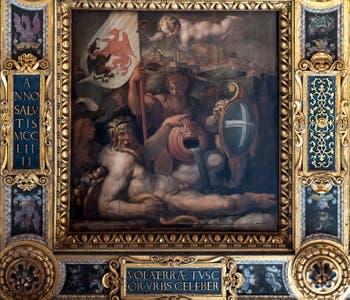
Allegory of Volterra In this allegory, Vasari presents a river deity that symbolizes the Cecina River with a horn filled with fruit and a young man who represents the city of Volterra and holds a standard in one hand and a coat of arms on the other.
The flag shows a red gryphon strangling an evil black gryphon while the coat of arms carries a white cross on a black background.
The city of Volterra is represented with its basilica and dungeon, while a flying putto holds a bishop's crozier to symbolize the siege of the bishopric of Volterra.
Under the allegory, we read the inscription:
“VOLTERRAE TOSCOR [UM] URBS CELEBER [RIMA]”.
Giorgio Vasari and Giovanni Stradano, “Allegory of Borgo San Sepolcro and Anghiari” Ceiling of the Hall of Five Hundred of Palazzo Vecchio in Florence
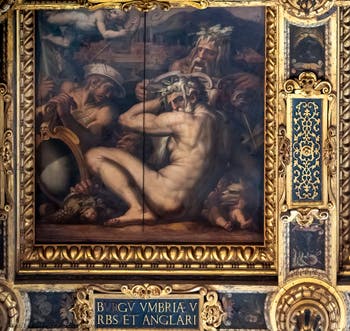
Borgo San Sepolcro and Anghiari In this allegory, Vasari depicted Emperor Flavius Arcadius as a pilgrim because the legend is that it was he who founded San Sepolcro.
Flavius Arcadius holds with one hand the standard of the city with a risen Christ and the white and black coat of arms of San Sepolcro on the other.
The old man seated to his right represents the Tiber River with the breastfeeding wolf Romulus and Remus.
We also notice the horn of abundance full of fruits.
The other old man where beech and fir mix with his hair and standing above the Tiber River represents the Apennines whose water flows from his mouth.
At the bottom, we see Borgo San Sepolcro and Anghiari and on the top and left a flying putto bearing a bishop's crozier, a symbol of the seat of the bishopric.
Under the allegory, it is read: “BURGU UMBRIAE URBS ET ANGLARI“.
Giorgio Vasari and Giovanni Stradano, “Allegory of San Giovanni Valdarno” Ceiling of the Hall of Five Hundred of Palazzo Vecchio in Florence
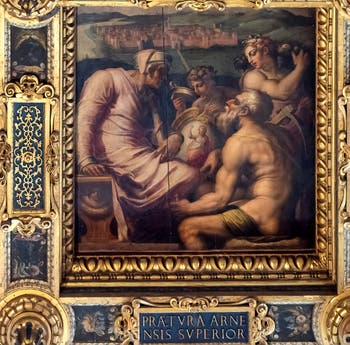
Allegory of San Giovanni Valdarno For the vicariate of San Giovanni Valdarno, also known for his court, Vasari represented a judge dressed in the antique and holding a roll of documents.
To the right of the painting is Vertumnus, the god of gardens and orchards, as well as Pomone, the nymph deity of fruits.
Vasari thus highlights the quality and abundance of fruit crops in this region.
Between them and in the centre is Bacchus crowned with vine leaves and grapes drinking the region's wine, the Trebbiano.
Bacchus also holds the coat of arms of San Giovanni Valdarno with a Saint John depicted on a white background.
The city of San Giovanni Valdarno, with its walled enclosure, is depicted in the painting's background.
The following words are painted under the allegory: “PREATURA ARNENSIS SUPERIOR”.
Giorgio Vasari and Giovanni Stradano, “Allegory of Romagna” Ceiling of the Hall of Five Hundred of Palazzo Vecchio in Florence

Allegory of Romagna In the notes relating to his paintings of the ceiling of the Hall of the Five Hundred of Palazzo Vecchio, Vasari specifies that in this allegory, he wanted to show the region of Castrocaro to the natural as well as its river, the Savio with a horn of abundance full of fruits to symbolize the agricultural wealth of this region.
He also indicates that he painted this beautiful, impetuous and helmet woman with a whip to show the audacity and resolution of the inhabitants of the region.
The Flaminia, the young woman who holds the flag, has at her feet the coat of arms with the red cross representing the insignia of Castrocaro.
Under the allegory, we read these words: “FLAMINIA NOSTRAE DITIONIS” which can be translated as “Our Mistress Flaminia”.
Giorgio Vasari and Giovanni Stradano, “Allegory of Cortona and Montepulciano” Ceiling of the Hall of Five Hundred of Palazzo Vecchio in Florence
The two cities are represented by the higher characters, who each carry a standard.
Allegory of Cortona and Montepulciano On the right-hand flag of the city of Cortona, there is a lion on a white background depicted on the coat of arms held by the young Bacchus.
On the left, the other male character holds the standard of Montepulciano and his coat of arms with a gryphon on a red background.
The allusion to Montepulciano is complemented by the presence of the old man representing the Chiana River with its horn of abundance from which olives and ears come out.
The young Bacchus wears a vase filled with wine produced in the region, highlighting the local wine, olives and cereal productions.
At the top of the painting, there is a flying putto holding a bishop's crozier in hand regarding the bishopric of Cortona.
The city of Montepulciano is depicted in the distance behind the characters.
Under the allegory, the following words are painted: “CORTONA POLITIANU [N] Q [EU] OPP [IDA] CLARA”.
Giorgio Vasari and Giovanni Stradano, “Allegory of Colle Val d'Elsa and San Gimignano” Ceiling of the Hall of Five Hundred of Palazzo Vecchio in Florence

Allegory of Colle Val d'Elsa The old man with the horn of abundance and the jug and the Elsa River with the banners and coats of arms represent the founders of the two cities represented in the background of the painting.
The banner of San Gimignano held on the left by a Bacchus is red and yellow, while in his hand, he has the coat of arms with his white lion.
The character on the right holds the flag of Colle Val d'Elsa with a red horse's head, which can also be seen in the upper right quarter of the red cross of the coat of arms.
Between Bacchus and the head of the old man, we can see the face of a young satyr drinking the Vernaccia, the wine of San Gimignano.
The following inscription is under the allegory: “GEMINIANUM AND OPIDA GLUE”.
Giorgio Vasari and Giovanni Stradano, “Allegory of Casentino” Ceiling of the Hall of Five Hundred of Palazzo Vecchio in Florence
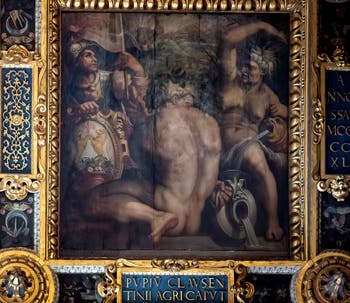
Allegory of Casentino In this allegory, we can see on the left a young man in armour holding a banner where one guesses a lion.
A symbol reused in the coat of arms he holds at his feet with two lions standing on their hind legs hold together Florence's Lys flower.
These lions and this young armed man represent the bravery of the inhabitants of the region and Poppi.
At the top of the painting, we see the cities of Pratovecchio and Bibbiena.
Two rivers are represented here with their vessels from which their waters flow.
It is, on the one hand, the Arno and the Archiano on the other.
The allegory reads: “PUP [P] IU [M] CLAUSENTINII AGRI CAPUT”.
Giorgio Vasari, Giovanni Stradano and Jacopo Zucchi, “Allegory of Chianti” Ceiling of the Hall of Five Hundred of Palazzo Vecchio in Florence
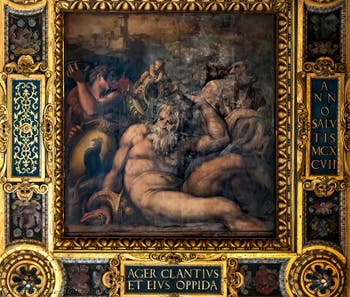
Allegory of Chianti Painting - Oil on Wood - 1563-1565
Vasari represented the two rivers of Chianti, that of the Pesa and Elsa.
The two rivers are represented with horns of abundance full of fruits.
A Bacchus, a symbol of good Chianti wines, is also present and holds the region's coat of arms with a black cock on a yellow background.
In the background, you can see the town of La Castellina in Chianti.
Under the allegory is written:
“AGER CLANTIUS AND EIUS OPPIDA”.
Ceiling Paintings Cosimo I Medici | Florence History | Wars and Battles | Tuscany
Five-Hundred Hall Hall and Ceiling | Ceiling Paintings | Pisa War | Siena War | Sculptures
Art Story Five-Hundred | Tower | Vasari Halls | Dante Mask | Ghirlandaio | Bronzino Sarto Daddi | Salviati | Cortile
Palazzo Vecchio Art Story | Location | Opening Hours Tickets | Authorizations
Back to Top of Page

